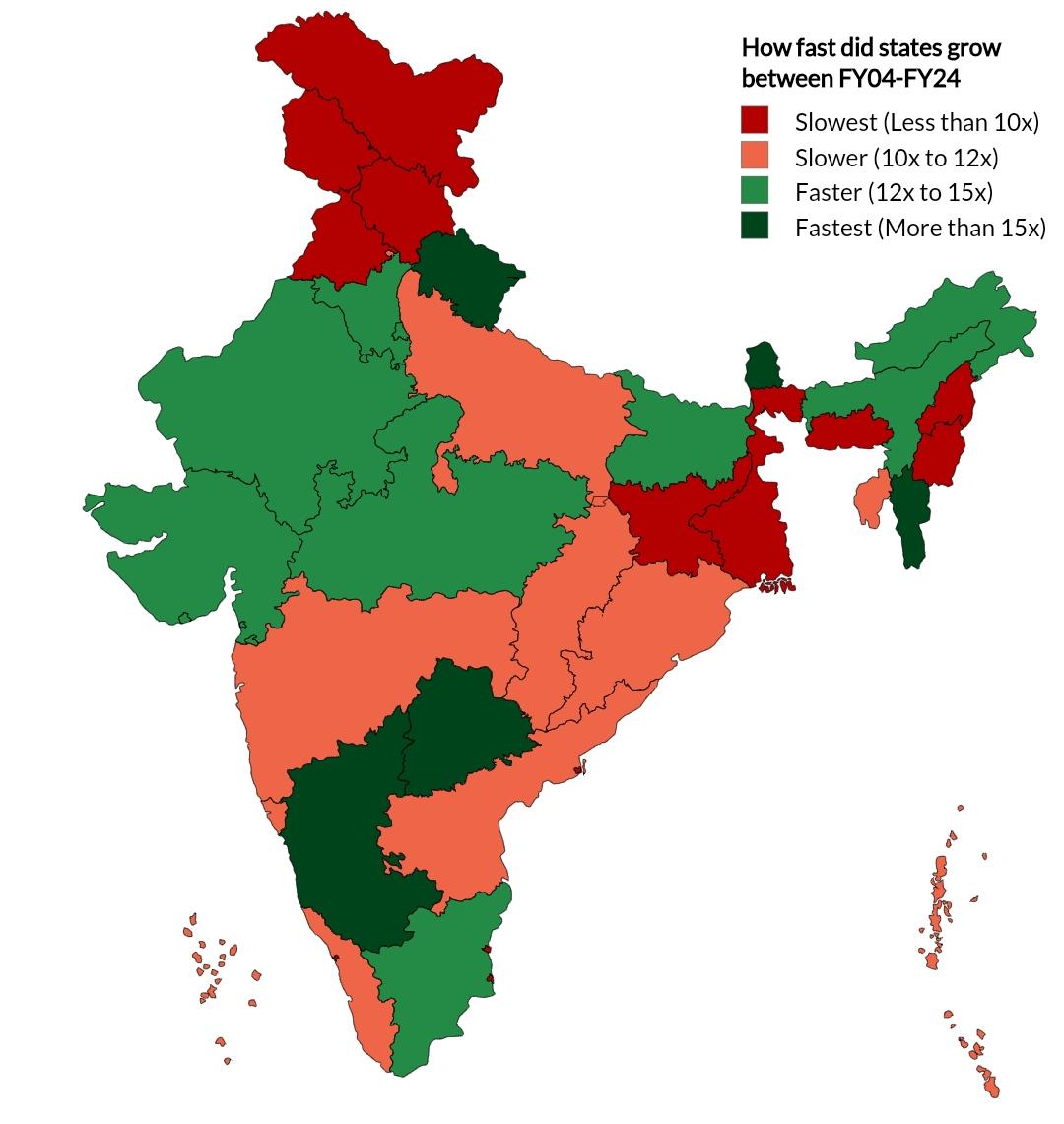Indian States GDP Growth Map Over Two Decades


David Chen
Data Visualization Specialist
David Chen is an expert in transforming complex geographic datasets into compelling visual narratives. He combines his background in computer science ...
Geographic Analysis
What This Map Shows
The map titled "How fast did Indian states grow in past two decades" provides a compelling visual representation of the economic growth of various Indian states from 2004 to the present. Utilizing data from the Ministry of Statistics and Programme Implementation (MOSPI), this visualization showcases the multiple of each state's GDP relative to its 2004 figures, underscoring the remarkable economic transformation that has taken place across the country. For instance, India as a whole has grown by a staggering 11 times its GDP in that span, reflecting significant changes in industry, infrastructure, and urbanization.
Deep Dive into Economic Growth in India
Ever wondered how this explosive growth came about? The economic story of India over the past two decades is one of resilience and dynamic change. After liberalization in the early 1990s, India began to open its markets, inviting foreign investments and fostering a more competitive business environment. This shift prompted a surge in GDP, but the growth has not been uniform across the nation.
Interestingly, each state has its own story and pace of growth influenced by various factors including governance, resource availability, industrialization, and education levels. For instance, states like Maharashtra and Gujarat have experienced phenomenal growth, primarily due to their robust industrial sectors and strategic locations. In contrast, states like Bihar and Uttar Pradesh, while growing, still grapple with challenges related to infrastructure and socio-economic development.
The technology sector has also played a crucial role, with cities like Bengaluru emerging as global IT hubs. This digital economy boom has not only contributed to GDP but has also created millions of jobs, attracting talent from across the nation and beyond.
Have you noticed how urbanization correlates with economic growth? Rapid urbanization has been a hallmark of this growth phase, with cities expanding and drawing in populations seeking better opportunities. As a result, metropolitan areas have seen some of the highest growth rates, which have directly contributed to the state’s GDP.
Regional Analysis
Let's break down the growth story by regions depicted in the map. In the western region, states like Gujarat and Maharashtra boast impressive growth multipliers, at around 12x and 10x respectively. This can largely be attributed to their industrial bases and ports facilitating trade.
Moving to the southern states, Karnataka stands out with its own 12x growth, largely driven by technology and services. Conversely, Tamil Nadu, while also growing, is at about 9x; it has a diversified economy but faces challenges such as labor issues and environmental concerns that have slowed its pace.
In northern India, states like Haryana have experienced substantial growth (around 8x) fueled by agriculture and real estate, while Punjab, despite its rich agricultural resources, has seen slower growth, around 6x, due to economic restructuring challenges.
Interestingly, in the east, West Bengal’s growth at approximately 7x shows a different trend. The state has been revitalizing its economy through investments in infrastructure and tourism, showcasing resilience amidst historical challenges.
Significance and Impact
Why does understanding the economic growth of Indian states matter? It goes beyond mere numbers; it has real-world implications for policy-making, investment decisions, and regional planning. As India strives to position itself as a global economic powerhouse, recognizing which states are thriving and why can help shape effective strategies for sustainable development.
Moreover, the disparities in growth rates highlight the need for targeted interventions in lagging states. Bridging the gap between high-growth and low-growth states is essential for balanced national development and social cohesion. With projections indicating continued growth in sectors like technology and manufacturing, understanding these trends will inform future economic policies and investments.
In conclusion, this map is not just a tool for visualizing growth; it tells the story of India’s economic journey over the last two decades, illustrating the opportunities and challenges that lie ahead. As we look to the future, it will be fascinating to see how these trends evolve and what new narratives emerge in the ever-changing landscape of Indian economics.
Visualization Details
- Published
- September 15, 2025
- Views
- 78
Comments
Loading comments...